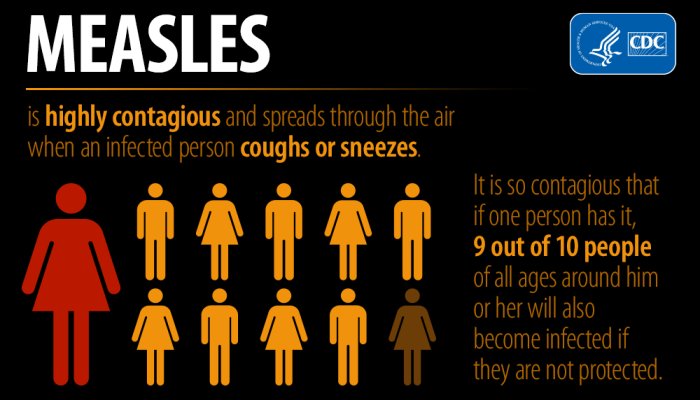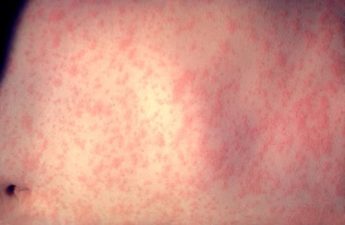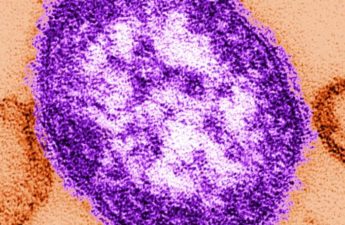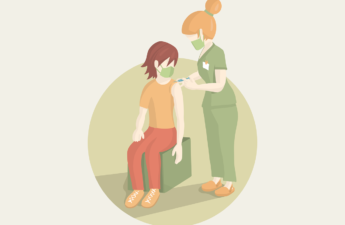
By Meredith Li-Vollmer, Public Health – Seattle & King County
Public Health – Seattle & King County is investigating a new measles case with possible exposures in King County. The King County resident, a six month old child, was taken to Seattle Children’s Hospital while she was contagious.
This is the fifth King County case identified this month, bringing the total to eight recent measles cases in Washington state residents.
This case was a household contact of a person diagnosed with measles earlier this month, and was not exposed to measles in the community.
Locations of potential exposure to the public of this measles case in King County
These times include the period when the child was at the location and two hours after. Measles virus can remain in the air for up to two hours after someone infectious with measles leaves the area.
Anyone who was at these locations during the times listed could have been exposed to measles. . Seattle Children’s Hospital is notifying patients and families in the emergency department who may have been exposed.
Before the measles diagnosis was made, the child was in the following public locations:
5/24/19 11 a.m. to 1:30 p.m. Seattle Children’s Hospital Emergency Department. 4500 40th Ave NE, Seattle, WA 98105 (no other locations in the hospital).
As more locations are identified, they will be added to a list of all measles cases and locations of exposure in King County at kingcounty.gov/measles/cases.
What to do if you were in a location of potential measles exposure
Most people in our area have immunity to the measles through vaccination, so the risk to the general public is low. However, anyone who was in the locations of potential exposure to measles around the times listed below should:
- Find out if you have been vaccinated for measles or have had measles previously. Make sure you are up-to-date with the recommended number of measles (MMR) vaccinations.
- Call a healthcare provider promptly if you develop an illness with fever or illness with an unexplained rash. To avoid possibly spreading measles to others, do not go to a clinic or hospital without calling first to tell them you want to be evaluated for measles.
- Vaccination or medication can be given after exposure in some cases to prevent illness – check with your healthcare provider. This is especially important for people at high risk for measles complications (see below).
Measles symptoms could appear starting from seven days after the first exposure to twenty-one days after the last exposure to someone with measles. Rash is most likely to appear a few days after the fever, ten to twelve days after an exposure.
More information about other cases in Washington state is available from the Washington State Department of Health. Public Health – Seattle & King Countycontinues to work with the Washington State Department of Health, Tacoma-Pierce County Health Department, and Snohomish Health District to identify any connections between these cases.
About measles
Measles is a highly contagious and potentially severe disease that causes fever, rash, cough, and red, watery eyes. It mainly spreads through the air after a person with measles coughs or sneezes.
Measles symptoms begin seven to 21 days after exposure to someone with measles. Measles is contagious from approximately four days before the rash appears through four days after the rash appears. People can spread measles before they have the characteristic measles rash.
Measles complications can include ear infections, diarrhea, pneumonia, and rarely, encephalitis (brain inflammation). Complications from measles can happen even in healthy people but those at highest risk include: infants and children under 5 years, pregnant women, people with weakened immune systems from drugs or underlying disease, and anyone who has not had two doses of MMR vaccine. If you are in one of these high-risk groups and were exposed to measles, be sure to contact your health care provider to discuss the need for treatment to prevent measles infection.
Measles is preventable with the safe and highly effective measles, mumps and rubella (MMR) vaccine. According to the Centers for Disease Control and Prevention (CDC), two doses of the MMR vaccine are more than 95 percent effective in preventing measles and that protection is long lasting.
What public health officials are doing
For more information about measles and measles vaccination: kingcounty.gov/measles
Investigation of infectious diseases is one of the essential services local health departments provide. Because of increased measles activity nationally, health departments throughout Washington state are also alerting healthcare providers and working with schools and communities to provide education about preventing measles.
NOTE: All exposure locations in King County, including those from previous cases, are updated at kingcounty.gov/measles/cases. Starting May 25, 2019, new cases of measles will be announced as updates to this blog piece, so please check back or go to the link listed above for the latest information. For major new developments in the outbreak, we will post new blog pieces.


